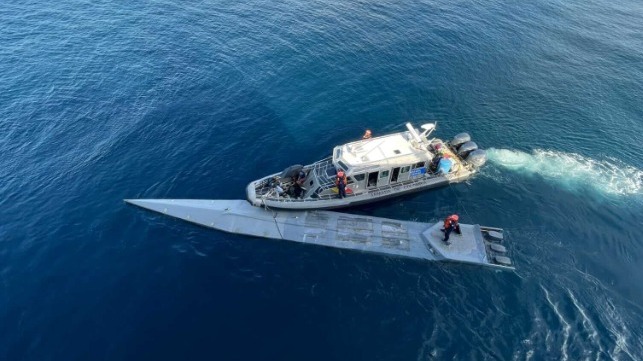U.S. Marine Corps Turns to Narco-Subs for Logistics Inspiration

Faced with the difficult task of defending remote islands in the Western Pacific, the U.S. Marine Corps is increasingly interested in autonomous systems for the high-risk role of combat logistics. The service's top R&D requirements officer told a conference on Wednesday that its researchers are developing an autonomous, low-profile supply boat designed around Colombian drug-running semisubmersibles. The idea has been proposed many times since 2020, and the Marine Corps is now running with it.
"[Semisubmersibles are] hard for us to find, so now we figured, yeah, it works,” said deputy commandant Lt. Gen. Karsten Heckl told Defense News on Wednesday. “We just copied the drug lords out of South America."
So-called "narco subs" have practical advantages for an operator in a contested environment, like moving cocaine through the well-patrolled waters off Colombia and Central America. These vessels have a small radar cross-section and visual profile, so they are difficult to find and intercept. They have a limited but useful cargo capacity, typically in the range of several tonnes. And their fiberglass hulls are cheap enough for a one-way delivery voyage. Most make it - more than enough to pay for the few that get caught and destroyed by the U.S. Coast Guard.
Unlike the traditional narco-sub, the Marine Corps' prototype is autonomous. It is built to deliver a cargo of two Naval Strike Missiles (NSMs) close to the beach - close enough that a team of Marines could offload the munitions and bring them to shore, Heckl told Defense News.
The lightweight Naval Strike Missile is an important element of the Marine Corps' new operating concept for warfare in the Pacific, which would see small Marine Corps units deploy to remote islands with the equipment to hold enemy ships at risk. Resupplying those far-flung units will be a key challenge for this operating concept, and Heckl believes that autonomy is part of the answer. The Marine Corps Warfighting Laboratory is working with a narco-sub prototype now, and acquisition could begin in a few years' time.
The Marine Corps and the Navy have already begun testing autonomous solutions with the specially-equipped fast transport USNS Apalachicola, an aluminum ro/pax catamaran that has been fitted with an autonomous navigation system. Heckl said that the ship has navigated about 1,500 nautical miles without human intervention.
These accessible, quick-to-develop, affordable solutions are in line with the direction that the Defense Department would like to go, according to Deputy Defense Secretary Kathleen Hicks. The Pentagon's newly-announced Replicator program aims to scale up existing autonomous solutions to meet the real needs of combatant commanders, within a two-year time horizon, Hicks told the Defense News conference on Wednesday.
